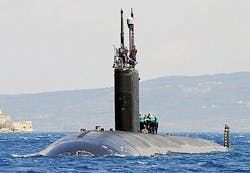Lockheed Martin to provide Navy submarines with 360-degree situational-awareness sail-mounted sonar
WASHINGTON, 25 March 2012. U.S. Navy officials needed special submarine sonar systems to help enable submarine commanders to enhance their tactical control when operating not only in shallow-water coastal areas and harbors, but also in open-ocean areas. They found their solution from the Lockheed Martin Corp. Mission Systems & Sensors segment in Liverpool, N.Y.
Officials of the Naval Sea Systems Command in Washington awarded Lockheed Martin a $13.1 million contract option last week for four Low-Cost Conformal Array (LCCA) sonar systems for high-frequency sonar coverage above and behind the submarine.
The LCCA is to be mounted on both sides of the submarine sail aboard Improved Los Angeles class fast attack submarines (SSN 688i), earlier-model 688-class boats, Seawolf-class attack submarines (SSN 21), Virginia-class attack submarines (SSN 774), and Ohio-class guided-missile submarines. Combined with the legacy high frequency sail array mounted in the front of the sail, the system provides 360-degree detection capability with high frequency passive sonar.
The LCCA is designed to help submarine commanders navigate safely among conventional and nuclear submarines and surface warships, as well as civil and commercial surface vessels by alerting submarine crews of short-range contacts.
The submarine will process LCCA signals with the on-board AN/BQQ-10 Acoustic Rapid COTS Insertion sonar system, otherwise known as A-RCI, which is for sonar signal processing using rapidly upgradable commercial off-the-shelf signal-processing and computer equipment.
On this contract, Lockheed Martin engineers will do the work in Syracuse, N.Y.; Walpole, Mass.; Forrest Hill, Md.; and Millersville, Md., and should be finished by November 2013.
For more information contact Lockheed Martin Mission Systems & Sensors online at www.lockheedmartin.com/us/ms2, or Naval Sea Systems Command at www.navsea.navy.mil.
Follow Military & Aerospace Electronics and Avionics Intelligence news updates on Twitter
